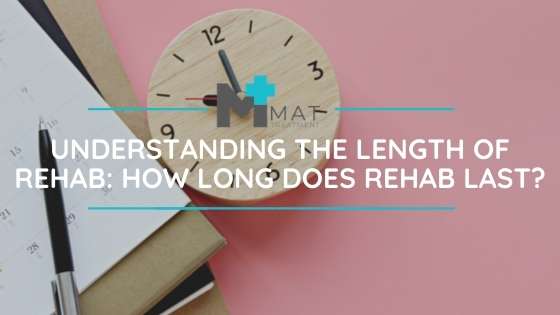Table of Contents
When you enter into treatment, there are a couple things that you’re going to wonder about. The first is will it work for you, and the second is the length of rehab? We understand that you want to know how long rehab takes, and we’re not only here to answer your questions, but we’re also going to let you know some reasons why treatment can take longer than you initially thought.
You’re going to want to read this guide from end to end to answer these questions and better understand the addiction recovery timeline. Let’s get right into the topic of rehab duration and more.
Table of Contents
What’s the Length of Rehab?
There are several types of programs that are offered to those entering into recovery. When you’re speaking with your care team, you’ll discuss each option that you have to find the one that will work the best for both you and your recovery needs.
The typical length of time used for rehab treatment include:
- 30 days
- 60 days
- 90 days
Of course, these time constraints aren’t set in stone and can vary based on several factors. Here’s an in-depth look into the factors that could lengthen or shorten your stay.
Continued Drug Use
It’s no secret that relapse is a part of the recovery process, relapse happens. There are going to be times where a slip up may happen, but that doesn’t mean you can’t bounce back and get back on the right course.
With that being said, continued drug use is a factor that can shorten the length of your time in rehabilitation treatment. Most inpatient rehab facilities have strict rules against drug use. These rules are in place because you’ve got to be serious about your treatment process.
If you’re continuing to use drugs, it shows that you may not be ready to quit entirely. The rules are also in place to protect other residents of the facility from being tempted to relapse and leave treatment altogether.
Number of Times You’ve Been to Treatment
The number of times you’ve been in treatment will also play a crucial role in the length of time you remain there. For those that are repeat residents in treatment, you may find yourself completing a longer rehab stay.
The reason for this is that it’s clear treatment in the past hasn’t worked for you, and your addiction is more severe than realized. That means you need more time to work through your issues at a more intensive level than before.
Severity of Addiction
How long have you been using? How often are you using? Have you ever tried to get sober? The severity of your addiction and your drug history is a huge factor in determining how long you will need to remain in treatment.
For example, if someone feels as if they could become addicted to a substance but haven’t reached a point where they must use every day or are craving something, they may simple attend a few meetings here and there.
But, on the other hand, someone that’s deep into their addiction and would do anything to support their habit will need much more intensive treatment. Knowing some things that could increase your treatment stay, here’s what you can expect once you’ve entered treatment.
Detox
The first step of treatment is to begin the detox process. You will be supervised by medically trained staff to ensure that nothing life-threatening takes place. Withdrawal symptoms can set in anywhere from minutes to a few hours after the last time you’ve used.
It can take upwards of 14 days to stop experiencing withdrawal symptoms.
Therapy Begins
Once you’ve gotten past the withdrawal process, you can then begin actively participating in individual and therapy sessions. In these sessions, you’ll interact with others in treatment and share your experiences and stories with one another.
In your individual therapy sessions, you’ll work with a counselor to take a more in-depth look at your addiction. You’ll begin to learn to identify your triggers and come up with ways to cope without relapsing.
Creating a New Normal
Another aspect of your treatment plan will be creating a new routine for yourself. Creating a routine will help you to establish structure that wasn’t there during your time of active use.
This is also when you’ll get to find out the things that you like doing or things that you don’t like. You may discover that exercising helps you rid yourself of feelings that would typically lead you to use it in the past.
Aftercare
Aftercare can be a scary part of the treatment plan, but it’s designed to help you make a smoother transition from treatment back to the real world. Your aftercare plan may be moving into a halfway house where you have the same structure and rules as treatment, but with more price pages and freedom.
In aftercare, you must take the time to do things like attend meetings or continue your new hobby. Half of those in recovery relapse before they’ve reached the one year mark.
The reason for this is once you’ve left treatment, it becomes apparent that talking about these triggers and actually being around these triggers are very different things. That’s why you must remain focused on your aftercare plan and take the necessary steps to remain strong in your sobriety. Aftercare may consist of intensive outpatient programming (IOP), outpatient rehab, sober living, and support groups.
The Length of Rehab: Only Time Will Tell
It’s hard to say what the true length of rehab is because several things could change it. Things that include the severity of your addiction as well as the number of times you’ve been to treatment in the past.
If you’re searching for a place that will provide you with the support and resources you need to get sober, contact Mat Treatment. Here we focus on helping you get to the bottom of your addiction issues and help you to learn ways to live soberly after treatment.
Get Help Today
Don’t go through the process of recovery alone. There are people who can help you with the struggle you’re facing. Get in touch with one today.



